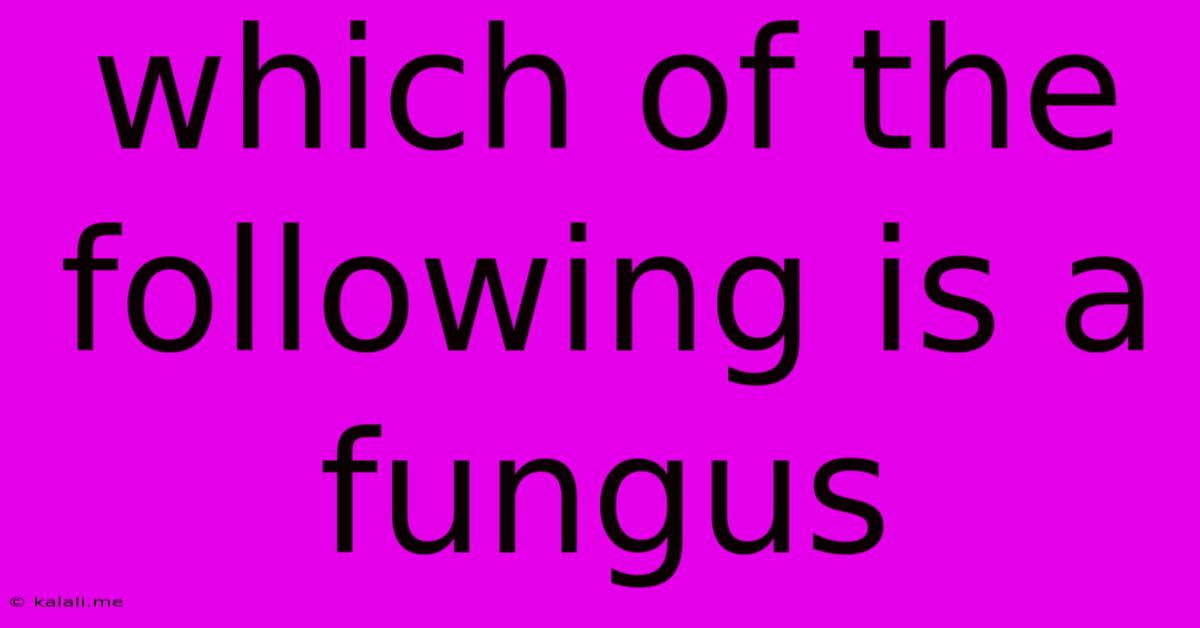Which Of The Following Is A Fungus
Kalali
Jun 14, 2025 · 3 min read

Table of Contents
Which of the following is a fungus? Identifying Fungi Among Other Organisms
This article will explore the characteristics of fungi and help you distinguish them from other organisms like plants, animals, and protists. Understanding the unique traits of fungi is crucial for correctly identifying them. This guide will provide you with the knowledge to confidently answer the question: which of the following is a fungus?
What are Fungi?
Fungi are a kingdom of eukaryotic organisms that are distinct from plants, animals, and bacteria. They are characterized by several key features:
- Heterotrophic Nutrition: Unlike plants, fungi cannot produce their own food through photosynthesis. Instead, they obtain nutrients by absorbing organic matter from their surroundings. This can be through decomposition (saprophytic fungi), parasitism (parasitic fungi), or symbiotic relationships (mycorrhizal fungi).
- Chitinous Cell Walls: Fungal cell walls are made of chitin, a tough polysaccharide also found in the exoskeletons of insects. This distinguishes them from plants, which have cell walls made of cellulose.
- Filamentous Structure (Hyphae): Most fungi are composed of thread-like structures called hyphae. These hyphae branch and intertwine to form a network called mycelium, which makes up the bulk of the fungal organism. Yeasts are a notable exception, being single-celled fungi.
- Spore Reproduction: Fungi reproduce both sexually and asexually, primarily through the production of spores. These spores are dispersed by wind, water, or animals, allowing fungi to colonize new environments.
- Diverse Morphology: Fungi exhibit an incredible diversity in their morphology, ranging from macroscopic mushrooms and toadstools to microscopic yeasts and molds.
Distinguishing Fungi from Other Organisms
To accurately identify a fungus, it's crucial to differentiate it from other kingdoms:
- Plants: Plants are autotrophic, producing their own food through photosynthesis. They have cellulose cell walls and typically reproduce via seeds or spores (although the mechanism differs significantly from fungal spore production).
- Animals: Animals are heterotrophic but ingest their food, unlike fungi which absorb nutrients. Animal cells lack cell walls.
- Protists: Protists are a diverse group of eukaryotic organisms, some of which are similar in appearance to fungi. However, protists exhibit a much wider range of nutritional strategies and cellular structures. Careful microscopic examination is often needed to distinguish them from fungi.
Examples of Fungi
To solidify your understanding, let's look at some common examples of fungi:
- Mushrooms: The familiar fruiting bodies of many basidiomycete fungi.
- Molds: Rapidly growing fungi often found on decaying organic matter. Examples include Penicillium and Aspergillus.
- Yeasts: Single-celled fungi used in baking and brewing, such as Saccharomyces cerevisiae.
- Mycorrhizal fungi: Fungi that form symbiotic relationships with plant roots, aiding in nutrient uptake.
- Lichens: A symbiotic association between a fungus and an alga or cyanobacterium.
Conclusion
By understanding the key characteristics of fungi – heterotrophic nutrition, chitinous cell walls, filamentous structure (except yeasts), spore reproduction, and diverse morphology – you can confidently identify fungi among other organisms. Remember to consider the organism's nutritional method, cell wall composition, and reproductive strategy when making your determination. This knowledge allows you to accurately answer the question: which of the following is a fungus?
Latest Posts
Latest Posts
-
Which Of The Following Destroys All Microbial Life
Jun 15, 2025
-
Example Of Motivation Letter For Job Application Pdf
Jun 15, 2025
-
Which Of These Is A Cation
Jun 15, 2025
-
4 Is Subtracted From The Cube Of A Number
Jun 15, 2025
-
What Are A Group Of Stars Called
Jun 15, 2025
Related Post
Thank you for visiting our website which covers about Which Of The Following Is A Fungus . We hope the information provided has been useful to you. Feel free to contact us if you have any questions or need further assistance. See you next time and don't miss to bookmark.